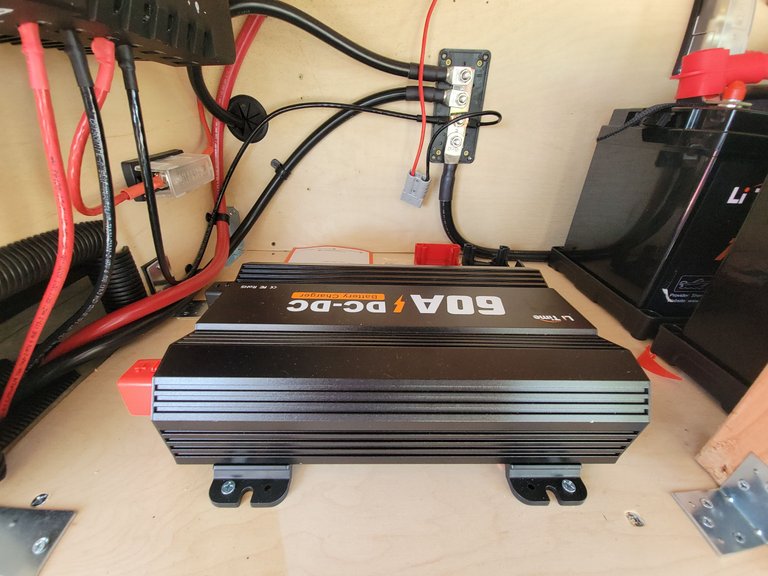Future DC-DC Charger Project

For a future project, I installed a 60A DC-DC battery charger to enable charging my batteries from the alternator of my truck. Although I haven't yet wired it to my battery bank or prepped my truck for it, this setup will offer several significant advantages once completed.
Purpose of the DC-DC Battery Charger
The 60A DC-DC battery charger is designed to take power from the truck's alternator and convert it to the optimal charging voltage and current for my battery bank. This type of charger is especially beneficial for maintaining the health and efficiency of lithium iron phosphate (LiFePO4) batteries, which require precise charging parameters.
Benefits of the DC-DC Charger
Quick Charging on the Road:
High Current Output: With a 60A output, the DC-DC charger can quickly charge the battery bank while the truck is running, ensuring that the batteries are replenished during travel.
Efficiency: The charger maximizes the alternator's output, converting it into a higher voltage suitable for the battery bank, thus ensuring efficient energy transfer and faster charging times.
Charging While Idling:
Alternator Utilization: Even when the truck is idling, the alternator continues to produce power. The DC-DC charger can harness this power to provide a steady charge to the battery bank, offering a useful trickle charge in situations where solar or other charging methods are not available.
Emergency Backup: In a pinch, this setup provides a reliable way to recharge the battery bank if other charging sources are insufficient or unavailable, enhancing the system's overall resilience.
Future Project Goals
Wiring the DC-DC Charger to the Battery Bank:
High-Quality Cables: Using appropriately rated, high-quality cables to connect the DC-DC charger to the battery bank ensures safe and efficient power transfer. The cables should be capable of handling the 60A current without significant voltage drop or overheating.
Secure Connections: Ensuring all connections are secure and properly insulated to prevent short circuits or accidental disconnections.
Preparing the Truck:
Mounting the Charger: Finding a suitable location in the trailer to mount the DC-DC charger (done), ensuring it is well-ventilated to prevent overheating and easily accessible for maintenance.
Integration with the Electrical System: Integrating the charger into the truck's electrical system without interfering with existing components. This may involve installing additional fuses or relays to protect both the truck's alternator and the battery charger.
Practical Usage Scenarios
On the Road:
Continuous Charging: While driving, the alternator generates power, which the DC-DC charger converts into a suitable form for the battery bank. This continuous charging ensures that the battery bank is kept at optimal levels, reducing the reliance on solar panels or other charging methods.
Long Trips: For extended road trips, the ability to charge the battery bank from the truck's alternator ensures that power-hungry appliances and devices in the trailer have a reliable energy source.
Stationary Charging:
Idle Charging: When parked and idling, such as during stops or when camped without adequate sunlight, the DC-DC charger can still provide a useful amount of charge to the battery bank, maintaining essential systems and preventing deep discharges.
Considerations for Installation
Current Draw on Alternator:
Alternator Capacity: Ensuring that the truck’s alternator has sufficient capacity to handle the additional load from the DC-DC charger without overloading or reducing the lifespan of the alternator. My particular truck has dual alternators and batteries so I have ample capacity.
Heat Management: Monitoring the alternator's temperature during operation to prevent overheating, especially during extended periods of idling.
Battery Management System (BMS) Compatibility:
Safety Features:
Fuses and Breakers: Installing appropriate fuses or circuit breakers in the wiring to protect against short circuits and overcurrent conditions.
Disconnect Switches: Including manual disconnect switches to isolate the DC-DC charger from the battery bank and the truck’s electrical system when necessary.
In summary, the installation of a 60A DC-DC battery charger will significantly enhance my ability to charge the battery bank from the truck’s alternator, providing quick and efficient charging on the road and useful charging capabilities while idling. This upgrade will ensure that my battery bank remains charged and ready, enhancing the overall reliability and flexibility of my power system.
For real brother this setup looks pretty great for keeping things charged up on the road. It's smart to plan ahead with quality cables and secure connections, never know when you're going to be needing extra charge
💪😎👊 I bet u have no fear of a power outage!